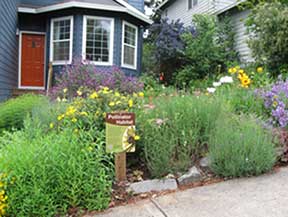 |
Previous Issues |
| Cedar Mill Community Website |
|
Search the Cedar Mill News: |
About The Cedar Mill News |
|
|||||||
| Volume 13, Issue 5 | May 2015 |
||||||
Confused about “Scaping”? Backyard conservation demystified.
|
|||||
 |
A variation on naturescaping, meadowscaping converts your lawn into a more natural setting, improving storm water infiltration, water quality, and wildlife habitat without requiring polluting practices such as fertilizing and mowing. A meadowscape is a planting that utilizes the principles of meadows, but in a smaller space than a traditional meadow. It includes diverse plantings of native wildflowers and grasses. Meadows are allowed to go to seed, minimizing the need to replant each year. In some neighborhoods, this can cause a bit of a stir if weed ordinances and covenants are on the books, so be sure to know your area before you start!
Learn more at wmswcd.org
 |
This is a polite term for what is also known as “hellstrip gardening,” that is, trying to do something a little more wildlife friendly in that difficult space between the sidewalk and the curb. In her recent popular book of the same name, Evelyn Hadden explains that the curb strip is a no-man’s land of sorts – privately owned, but part of the public landscape. This strip of dirt between the sidewalk and the street can be a difficult place to grow anything, let alone native plants that thrive in native soils typically lacking here.
Many other factors contribute to the headache: lack of water, heat reflected from paved surfaces, foot traffic, trash, animal waste, and poor drainage, to name a few. Curbscaping encourages you to work with what you have, even if the conditions in that space are vastly different from the rest of your yard. You can chose natives that support insect and wildlife habitat, but you will have to select species that make sense for these unique conditions. Grasses, sedges, and tougher forbs are all great ideas. Bushes and trees must be selected with care due to space constraints and safety of sightlines.
Learn more at evelynhadden.com
 |
Love pollinators? Interested in soil macroinvertabrates? Bugscaping is the trend for you! This concept creates habitat for native plants and insects from neglected spaces, sometimes providing a space for research and education in the process. Like all “scaping” projects, the entry knowledge level is low. But true success does require careful planning to select plants that have relationships with local insects. So how to know what to plant? You can consult local native plant guides for beneficial insect relationships. Keep an eye out for tough growing conditions (see curbscaping above).
Learn more at the Xerces Society website: xerces.org
![]()
Like us on Facebook for timely updates
Published monthly by Pioneer Marketing & Design
Publisher/Editor:Virginia Bruce
info@cedarmillnews.com
PO Box 91061
Portland, Oregon 97291
© 2013